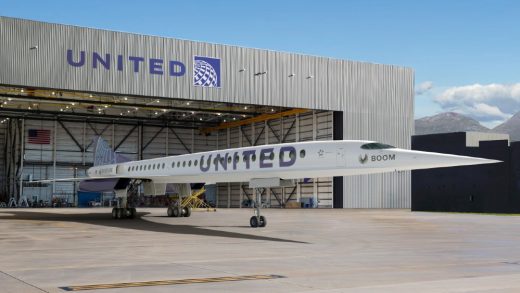United Airlines is buying 15 supersonic aircraft from Boom Supersonic

Depending on safety tests, United may increase its order to 50 supersonic jets
United Airlines has agreed to purchase 15 supersonic aircraft from Boom Supersonic, with an option to increase that order to 50 jets, the companies announced Thursday. That agreement, though, is still subject to change depending on the outcome of United’s safety testing and also Boom’s ability to deliver on its promises despite never having built or flown a full-scale supersonic jet before.
If Boom’s Overture jets pass inspection, the plan is for them to be rolled out in 2025, fly in 2026, and expected to carry passengers by 2029. At that point, Boom claims its supersonic jets will eventually be able to travel from New York to London — normally a seven-hour flight — in just 3.5 hours, or Los Angeles to Sydney — typically a 15-hour trip — in six hours and 45 minutes. Boom has said that tickets will cost $5,000 per seat, but United says it’s too early to announce pricing.
“A STELLAR FLIGHT EXPERIENCE”
“Boom’s vision for the future of commercial aviation, combined with the industry’s most robust route network in the world, will give business and leisure travelers access to a stellar flight experience,” United CEO Scott Kirby said.
It’s the latest deal for Boom, the startup that has been focused on resurrecting commercial supersonic air travel. In addition to United, the company has contracts or memorandum of understanding with Rolls-Royce and the US Air Force. Boom has raised $240 million in funding and fielded preorders from Virgin Group (which is also working on its own supersonic jet) and Japan Airlines.
To be sure, Boom has only just revealed its first full-scale XB-1 demonstrator aircraft, which is scheduled to take its inaugural flight in 2021. At 71 feet long, the XB-1 is a scaled-down version of the full production model that Boom hopes to have ready for passengers by 2029. The prototype only has room for the pilot, while the commercial-ready version will eventually hold up to 88 passengers and crew.
The demonstrator is expected to reach speeds of Mach 1.3, thanks to its three J85-15 engines, which are manufactured by General Electric, primarily for military aircraft. By comparison, the full-scale Overture jet will be 205 feet long, have a cruising altitude of 60,000 feet, and achieve speeds of Mach 1.7.
Both companies claim the jets will be “net-zero carbon from day one [and] optimized to run on 100 percent sustainable aviation fuel.” But neither provided additional details about what kinds of fuel they would be using or how they would achieve net-zero carbon emissions.
Environmental groups are worried that faster speeds will equal more pollution into the environment. The global aviation industry produces around 2 percent of all human-induced CO2 emissions, but supersonic jets are known to be far more polluting. Boom says it will be carbon-neutral as a goal, but simply put, it takes more fuel to go faster.
IT TAKES MORE FUEL TO GO FASTER
Boom is behind schedule, having promised to begin flight tests by 2017 in the hopes of ferrying real passengers in 2020. Now, that timeline has been set back nearly a decade. There hasn’t been a supersonic commercial jet in operation since Concorde, constructed by French aerospace company Aérospatiale and British Aircraft Corporation, was retired after 27 years of service in 2003. Concorde was a gas-guzzler and a money-loser for Airbus.
Boom is also testing new technologies that could muffle the sonic boom that occurs when a supersonic airplane breaks the sound barrier. These cannon-blast booms led Congress to ban supersonic jets from flying over US soil in 1973. But in October 2018, President Trump signed a billdirecting the Federal Aviation Administration to consider lifting the ban. It’s unclear where President Joe Biden, who has made infrastructure and climate change a hallmark of his early days in office, stands on supersonic travel.
Update June 3rd, 12:46PM ET: United said it would purchase 15 jets from Boom Supersonic, with the option to buy 35 more, for a total of 50 aircraft. Also, Boom has said that its tickets would cost $5,000 per seat, but United hasn’t announced pricing yet. This story has been updated to reflect these facts.